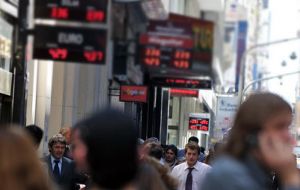MercoPress. South Atlantic News Agency
US dollar in Argentina’s ‘blue’ (parallel) market soars 5% on Tuesday
 Markets are nervous and manufacturers are asking for a US dollar of 5.40 Pesos
Markets are nervous and manufacturers are asking for a US dollar of 5.40 Pesos The US dollar in Argentina’s parallel market soared on Tuesday as strong unsatisfied demand moved to the so called ‘blue’ market as a result of the increasing controls for the purchase of the greenback.
Trading started at 5.25 Argentine pesos to the dollar but quickly jumped 27 cents to 5.52 and 5.55, (5%) the largest leap in a single day in the last ten years. In April 2002, following the Argentine default on its sovereign debt the US dollar at the time soared 26 cents from 2.89 to 3.15 Pesos.
The volatility of the US dollar in the blue market is attributed to the controls imposed by the Argentine Federal Revenue Service, AFIP, in combination with the central bank.
Although there is no official written resolution the oral instructions to money traders and exchange houses it that individuals can only purchase dollars up to 25% of their proven monthly income. Last week it was 40%. To this must be added the difficulties faced by importers to obtain dollars for their operations and to make payments overseas.
Nevertheless analysts agree that Tuesday’s jump is temporary and in coming days demand is expected to yield, since the micro operations tendency was unrelated to what happened with the large operations market which remained basically unchanged at 4.46 and 4.48 Pesos to the US dollar. Further more the Central bank closed trading on Tuesday having a surplus purchase of 150 million dollars.
Likewise the turbulent international scenario is forcing the Argentine central bank (short of hard currency) to adapt to the new conditions of the market particularly in the region where Brazil is implementing a policy of gradual but sustained devaluation of its currency which now for the second day running averaged 2 Reais to the US dollar.
Meantime the “forward cash” operations which mean purchasing Argentine bonds or shares traded in New York in Buenos Aires in Argentine pesos, and then convert them into US dollars, a good way of evading local controls, stood at 5.86 Pesos to the Dollar.
But in spite of controls to stop hard currency fleeing from the country, Argentina faces a more serious challenge since its main trade partner Brazil in implementing a pro-exports policy by depreciating its currency.
Since the end of March, the Brazilian Real has lost 7.7% against the US dollar, well above inflation. However in the same period the dollar in Argentina increased 1.6%, from 4.39 to 4.46 Pesos, which is below the inflation rate and makes the Peso stronger and less competitive for exporters.
The Brazilian change in policy is explained by a slower performance of the Asian and Latin American economies while the US remains stalled and Europe is in free fall. With fiscal, exchange and monetary policies Brazil is rapidly depreciating its currency to make its exports more competitive.
A report from economic consultants Econometria points out that in the last 12 months to April the Real experienced 20% devaluation and the Peso 8% while inflation in Brazil was 5% and In Argentina, 21%. And since most Argentine manufactured goods end in Brazil, they are exposed to a market less avid and with lower purchasing power.
In March Argentine manufactured exports to Brazil dropped 5% and in April the percentage is expected to be even higher. The Argentine metallurgy sector revealed that demand form Brazil is down 18% compared to a year ago.
Precisely expressing this feeling during the 65th anniversary of the Chamber of Metallurgy Manufacturers in Cordoba members complained about the exchange rate and demanded a US dollar at 5.40 Pesos. Furthermore an opinion poll among industrialists showed that 59% of manufacturers stated that the current exchange rate (4.46) is not competitive and the figure jumps to 65% among those directly linked to the exports sector.




Top Comments
Disclaimer & comment rules-

-

-

Read all commentsSomeone explain please what a “Blue” market is?
May 16th, 2012 - 05:41 am 0I assume “blue market” is a literal translation from Spanish that loses it's meaning in English. It probably should be “grey market” as the article is talking about legal but unofficial methods of getting rid of Pesos and buying $US
May 16th, 2012 - 06:59 am 05 percent in one day... respect ! But no fear, Argentina is doing fine on its right path, true?
May 16th, 2012 - 09:55 am 0Commenting for this story is now closed.
If you have a Facebook account, become a fan and comment on our Facebook Page!